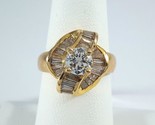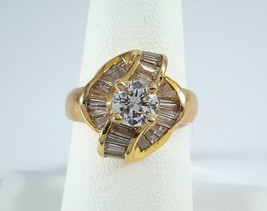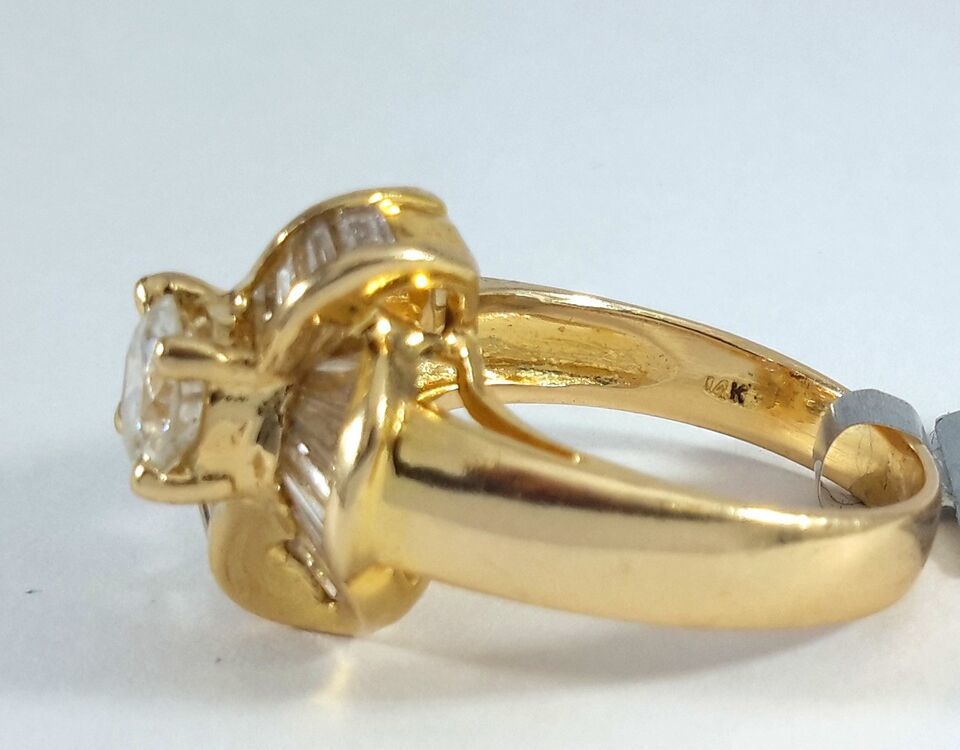Rendered at 21:57:58 05/22/25
Shipping options
Seller handling time is 3 business days Details
FREE in United States
Offer policy
OBO - Seller accepts offers on this item.
Details
Return policy
None: All purchases final
Purchase protection
Payment options
PayPal accepted
PayPal Credit accepted
Venmo accepted
PayPal, MasterCard, Visa, Discover, and American Express accepted
Maestro accepted
Amazon Pay accepted
Nuvei accepted
Shipping options
Seller handling time is 3 business days Details
FREE in United States
Offer policy
OBO - Seller accepts offers on this item.
Details
Return policy
None: All purchases final
Purchase protection
Payment options
PayPal accepted
PayPal Credit accepted
Venmo accepted
PayPal, MasterCard, Visa, Discover, and American Express accepted
Maestro accepted
Amazon Pay accepted
Nuvei accepted
Item traits
| Category: | |
|---|---|
| Quantity Available: |
Only one in stock, order soon |
| Condition: |
Pre-owned |
| Brand: |
Unbranded |
| Main Stone: |
Diamond |
| Metal: |
Yellow Gold |
| Metal Purity: |
14k |
| Ring Size: |
6.5 |
| Type: |
Ring |
| Secondary Stone: |
Diamond |
| Style: |
Shaped |
| Main Stone Shape: |
Round |
| Main Stone Creation: |
Natural |
| Total Carat Weight: |
1.50 - 1.74 |
| Main Stone Treatment: |
Not Enhanced |
| Occasion: |
Engagement |
| Sizable: |
Yes |
| Seller Notes: |
“In Excellent Condition.” |
| Jewelry Type: |
Ring |
| Fancy Diamond Color: |
White |
| Use Occasion: |
Engagement |
| Total Carat Weight (TCW): |
1.65 |
| Diamond Color: |
J-K-L |
| Clarity: |
I1 |
Listing details
| Seller policies: | |
|---|---|
| Shipping discount: |
Seller pays shipping for this item. |
| Posted for sale: |
More than a week ago |
| Item number: |
1722141732 |
Item description
Message Us For More Info!
0.65ct Round DIAMOND on 14k Yellow GOLD Ring - R9880
This lovely Yellow Gold ring is set with one brilliant Diamond wrapped around by smaller baguette Diamonds.
Main Stone: Diamond
Stone Weight: 0.65ct
Secondary Stone: Diamond
Secondary Stone Weight: 1.00ct
Average diamond color: J
Average Clarity: Si2
Metal: Yellow Gold
Metal Weight: 6.50 grams
Metal Purity: 580 / 14k
Ring Size: 6.5
Store Reference#: R9880
Continue browsing our collection
Diamond
Diamond
The slightly misshapen octahedral shape of this rough diamond
crystal in matrix is typical of the mineral. Its lustrous faces also
indicate that this crystal is from a primary deposit.
General
Category
Native minerals
Dana classification
1.3.6.1
Identification
Color
Typically yellow, brown, or gray to colorless. Less often blue,
green, black, translucent white, pink, violet, orange, purple, and red.
Diamond
(pronunciation: /?da??m?nd/ or /?da?m?nd/) is a metastable allotrope of
carbon, where the carbon atoms are arranged in a variation of the
face-centered cubic crystal structure called a diamond lattice. Diamond
is less stable than graphite, but the conversion rate from diamond to
graphite is negligible at standard conditions. Diamond is renowned as a
material with superlative physical qualities, most of which originate
from the strong covalent bonding between its atoms. In particular,
diamond has the highest hardness and thermal conductivity of any bulk
material. Those properties determine the major industrial application of
diamond in cutting and polishing tools and the scientific applications
in diamond knives and diamond anvil cells.
Because of its
extremely rigid lattice, it can be contaminated by very few types of
impurities, such as boron and nitrogen. Small amounts of defects or
impurities (about one per million of lattice atoms) color diamond blue
(boron), yellow (nitrogen), brown (lattice defects), green (radiation
exposure), purple, pink, orange or red. Diamond also has relatively high
optical dispersion (ability to disperse light of different colors).
Most
natural diamonds are formed at high temperature and pressure at depths
of 140 to 190 kilometers (87 to 118 mi) in the Earth's mantle.
Carbon-containing minerals provide the carbon source, and the growth
occurs over periods from 1 billion to 3.3 billion years (25% to 75% of
the age of the Earth). Diamonds are brought close to the Earth's surface
through deep volcanic eruptions by magma, which cools into igneous
rocks known as kimberlites and lamproites. Diamonds can also be produced
synthetically in a HPHT method which approximately simulates the
conditions in the Earth's mantle. An alternative, and completely
different growth technique is chemical vapor deposition (CVD). Several
non-diamond materials, which include cubic zirconia and silicon carbide
and are often called diamond simulants, resemble diamond in appearance
and many properties. Special gemological techniques have been developed
to distinguish natural diamonds, synthetic diamonds, and diamond
simulants. The word is from the ancient Greek ?????? ? adamas
"unbreakable".
History
The
name diamond is derived from the ancient Greek ?????? (adamas),
"proper", "unalterable", "unbreakable", "untamed", from ?- (a-), "un-" +
????? (dama?), "I overpower", "I tame". Diamonds are thought to have
been first recognized and mined in India, where significant alluvial
deposits of the stone could be found many centuries ago along the rivers
Penner, Krishna and Godavari. Diamonds have been known in India for at
least 3,000 years but most likely 6,000 years.
Diamonds have
been treasured as gemstones since their use as religious icons in
ancient India. Their usage in engraving tools also dates to early human
history. The popularity of diamonds has risen since the 19th
century because of increased supply, improved cutting and polishing
techniques, growth in the world economy, and innovative and successful
advertising campaigns.
In 1772, the French scientist Antoine
Lavoisier used a lens to concentrate the rays of the sun on a diamond in
an atmosphere of oxygen, and showed that the only product of the
combustion was carbon dioxide, proving that diamond is composed of
carbon. Later in 1797, the English chemist Smithson Tennant repeated
and expanded that experiment. By demonstrating that burning diamond
and graphite releases the same amount of gas, he established the
chemical equivalence of these substances.
The most familiar
uses of diamonds today are as gemstones used for adornment, a use which
dates back into antiquity, and as industrial abrasives for cutting hard
materials. The dispersion of white light into spectral colors is the
primary gemological characteristic of gem diamonds. In the 20th century,
experts in gemology developed methods of grading diamonds and other
gemstones based on the characteristics most important to their value as a
gem. Four characteristics, known informally as the four Cs, are now
commonly used as the basic descriptors of diamonds: these are carat (its
weight), cut (quality of the cut is graded according to proportions,
symmetry and polish), color (how close to white or colorless; for fancy
diamonds how intense is its hue), and clarity (how free is it from
inclusions). A large, flawless diamond is known as a paragon.
Continue browsing our collection
Available Shipping Worldwide
GTAonline
Please be sure to check ALL the item's details to avoid confusion.
Added to your wish list!

- 0.65ct Round DIAMOND on 14k Yellow GOLD Ring - R9880
- 1 in stock
- Price negotiable
- Handling time 3 days.
Get an item reminder
We'll email you a link to your item now and follow up with a single reminder (if you'd like one). That's it! No spam, no hassle.
Already have an account?
Log in and add this item to your wish list.















